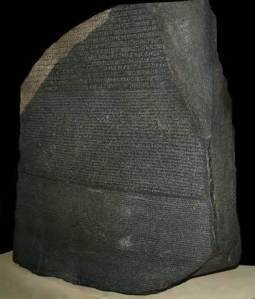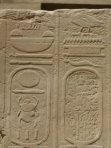Written in Stone
 In yesterday’s post I mentioned the spark that started the French Revolution. Today’s post starts there too. While the sun was setting on the Sun King’s grandson, Louis XVI, a new star was on the rise — Napoleon Bonaparte. With the concept in mind that Egypt would make a fine French colony, and with Vive la République! simmering in their blood, they also had the vague idea to liberate the native peoples from the Marmluke caste (soldier slaves). Napoleon headed there.
In yesterday’s post I mentioned the spark that started the French Revolution. Today’s post starts there too. While the sun was setting on the Sun King’s grandson, Louis XVI, a new star was on the rise — Napoleon Bonaparte. With the concept in mind that Egypt would make a fine French colony, and with Vive la République! simmering in their blood, they also had the vague idea to liberate the native peoples from the Marmluke caste (soldier slaves). Napoleon headed there.
In the town of Raschid lay a discovery that would change how we viewed Ancient Egypt — the Rosetta Stone. (Raschid was also called Rosetta) Today, July 15th, marks the anniversary of that discovery 215 years ago.
My morning research turned up several details on the discovery so I won’t put anything on my blog as a fact unless there are sources to back up the fact. Here are two versions:
A. French soldiers found just lying on the ground.
B. French soldiers were extending the walls of Fort Julien and found it then.
However it was found, the person who did the finding that July in 1799 was Pierre Francois-Xavier Bouchard, Napoleon’s officer of engineers. He sent the slab to the Institut d’Egypte in Cairo along with other antiquities turning up now and again. After Admiral Nelson won the day in the Battle of Aboukir Bay, better known as the Battle of the Nile, France left Egypt in defeat and the Rosetta Stone made its way to London in 1802.
What is the Rosetta Stone?
The Rosetta Stone is a stone slab, a piece of a larger stele, inscribed with a decree from the time of King Ptolemy V (196 B.C.E.). The inscription was obviously meant for everyone living in Egypt at the time because the same  information was written in three languages – Demotic (discovered to be a common document script), Greek (that every university student knew), and Hieroglyphic (a total mystery). By comparing all three languages and leaning heavily on the understandable Greek, scholars realized the Egyptian pictures went in bunches or cartouches. These cartouches basically amounted to words. What made this an amazing find is up to that point, Egyptian hieroglyphs were seen as just a bunch of decorative pictures.
information was written in three languages – Demotic (discovered to be a common document script), Greek (that every university student knew), and Hieroglyphic (a total mystery). By comparing all three languages and leaning heavily on the understandable Greek, scholars realized the Egyptian pictures went in bunches or cartouches. These cartouches basically amounted to words. What made this an amazing find is up to that point, Egyptian hieroglyphs were seen as just a bunch of decorative pictures.
So many precious artifacts were plundered from ancient sites around the world by the people who occupied them in centuries past. Needless to say, Egypt wants it back.
More~
http://science.howstuffworks.com/environmental/earth/geology/rosetta-stone.htm
The Rosetta Stone: translation of the demotic text
۞>>>>۞<<<<۞

For 100 days, I’ll post something from my chosen topic: Clichés. There are 70 entries to come.
Here’s a cliché for today:
Written in Stone
۞>>>>۞<<<<۞
 Today our guest is Author Tessie Bradford
Today our guest is Author Tessie Bradford
http://romancebooks4us.blogspot.com/
The July contest is on and all the prizes go to ONE WINNER! http://www.romancebooks4us.com
۞>>>>۞<<<<۞
 Love Waits in Unexpected Places - Scorching Samplings of Unusual Love Stories
Love Waits in Unexpected Places - Scorching Samplings of Unusual Love Stories
Find my novels wherever books are sold.
Sample my love stories for free!
۞>>>>۞<<<<۞






